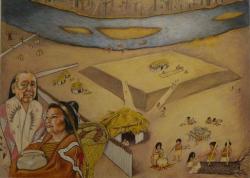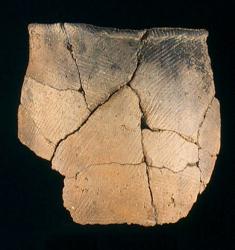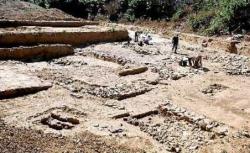INSTITUT SUPERIEUR D'ANTHROPOLOGIE
INSTITUTE OF ANTHROPOLOGY
ONLINE COURSES / COURS A DISTANCE
INSCRIPTION : Année Universitaire 2012/2013
REGISTRATION : Academic Year 2012 / 2013
USA –  Naval Live Oaks - In January 2006, archaeologists conducting a survey for a proposed boardwalk in the Naval Live Oaks section of the Gulf Islands National Seashore in Gulf Breeze uncovered a 1,000-year-old Indian burial site. They found the remains of four people, including an infant, as well as hundreds of fragments of sacred burial artifacts — prehistoric pottery shards, a stone and metal fragments. Six years later, the the Choctaw Nation of Oklahoma has claimed the remains. They are to be turned over to the Choctaws if no other tribe steps forward with another claim by a Sept. 10 deadline. The Pensacola area is considered the ancestral land of the Choctaw tribe, even though at least a dozen other tribes, including the Poarch Creek and Seminoles, were known to live or migrate through here. Norma Harris, a research associate with the Archaeology Institute, did not work directly with the remains but is an an expert on native people of this area. She said it’s not unusual to find artifacts dating back 8,000 to 12,000 years just about anywhere in the Pensacola area. That’s because people were attracted to the Panhandle because of its food-rich rivers and bays converging with the Gulf of Mexico and its forests teeming with wildlife and plants, she said. Harris, who was instrumental in having Naval Live Oaks listed on the National Register of Historic Places because of its rich archaeological significance, said 1,000 years ago there would have been very small, highly mobile families or groups in the area. “They’d come and fish, collect shellfish, collect acorns,” she said. The Naval Live Oaks area probably looked similar to how it does today, with oaks and pines. “There would have been thriving communities and trade networks,” she said. “Groups up to Michigan wanted shells from here, and there would have been extensive trade routes. There were no stones here. So they would have traded with other tribes for stones. It was a wonderful place to live then, just as it is now.”
Naval Live Oaks - In January 2006, archaeologists conducting a survey for a proposed boardwalk in the Naval Live Oaks section of the Gulf Islands National Seashore in Gulf Breeze uncovered a 1,000-year-old Indian burial site. They found the remains of four people, including an infant, as well as hundreds of fragments of sacred burial artifacts — prehistoric pottery shards, a stone and metal fragments. Six years later, the the Choctaw Nation of Oklahoma has claimed the remains. They are to be turned over to the Choctaws if no other tribe steps forward with another claim by a Sept. 10 deadline. The Pensacola area is considered the ancestral land of the Choctaw tribe, even though at least a dozen other tribes, including the Poarch Creek and Seminoles, were known to live or migrate through here. Norma Harris, a research associate with the Archaeology Institute, did not work directly with the remains but is an an expert on native people of this area. She said it’s not unusual to find artifacts dating back 8,000 to 12,000 years just about anywhere in the Pensacola area. That’s because people were attracted to the Panhandle because of its food-rich rivers and bays converging with the Gulf of Mexico and its forests teeming with wildlife and plants, she said. Harris, who was instrumental in having Naval Live Oaks listed on the National Register of Historic Places because of its rich archaeological significance, said 1,000 years ago there would have been very small, highly mobile families or groups in the area. “They’d come and fish, collect shellfish, collect acorns,” she said. The Naval Live Oaks area probably looked similar to how it does today, with oaks and pines. “There would have been thriving communities and trade networks,” she said. “Groups up to Michigan wanted shells from here, and there would have been extensive trade routes. There were no stones here. So they would have traded with other tribes for stones. It was a wonderful place to live then, just as it is now.”
http://www.pnj.com/article/20120809/NEWS/308090013/Ancient-remains-found-Naval-Live-Oaks-repatriated?odyssey=tab%7Ctopnews%7Ctext%7CFRONTPAGE
USA – Virginia City - Virginia City is a place where people who study our past love to dig holes and uncover artifacts. More than 150 years after silver boomed on the Comstock, much of the evidence of culture and livelihood left behind by the mining era inhabitants is covered over by the dirt, relentlessly moved around by wind and water. So, while the silver kings explored the mining camp ground from below, today's excavators dig from the top down. Virginia City's newest archaeological site is the backyard of what once was a community hospital in the late 1800s and now is home to an arts center. The grounds of St. Mary's Art and Retreat Center, once St. Mary Louise Hospital, run by the Daughters of Charity from 1876 to 1897, could give up some valuable clues to the practice of medicine in the late 1880s, along with examples of everyday household items. "It would be fun to find (medical) instruments," Elizabeth Bennett, a supervisor on the dig who will be a graduate student at the University of Nevada, Reno in the fall, told the Reno Gazette-Journal (http://on.rgj.com/QGHKaN). "We know there was a fire in the hospital, and they moved the debris out here. Sarah (Cowie) and the supervisors think things are 30 to 50 centimeters down, so maybe 12 to 20 inches."
http://www.10tv.com/content/stories/apexchange/2012/08/08/nv--hospital-archaeology-virginia-city.html
USA –  Potomac River - St. Mary’s College of Maryland recently received a grant from the National Endowment for the Humanities (NEH) for its “Colonial Encounters: The Lower Potomac River at Contact, 1500-1720 AD” project. The grant will fund personnel to research 33 settlements—archaeological sites once occupied by English colonists, enslaved and indentured Africans, and members of the Piscataway, Mattawoman, Potobac, and Patowomeck nations—on both sides of the Potomac River in Maryland and Virginia. A second portion of the grant will fund the expansion of the website, ChesapeakeArchaeology.org, a storehouse for findings and data from the research. Visitors to the site can view images of artifacts found at the various sites being studied.
Potomac River - St. Mary’s College of Maryland recently received a grant from the National Endowment for the Humanities (NEH) for its “Colonial Encounters: The Lower Potomac River at Contact, 1500-1720 AD” project. The grant will fund personnel to research 33 settlements—archaeological sites once occupied by English colonists, enslaved and indentured Africans, and members of the Piscataway, Mattawoman, Potobac, and Patowomeck nations—on both sides of the Potomac River in Maryland and Virginia. A second portion of the grant will fund the expansion of the website, ChesapeakeArchaeology.org, a storehouse for findings and data from the research. Visitors to the site can view images of artifacts found at the various sites being studied.
http://indiancountrytodaymedianetwork.com/2012/08/08/maryland-college-awarded-grant-to-study-potomac-river-archaeological-sites-127981
FRANCE -  Palaja - C'est une formidable découverte que l'équipe de fouilles archéologiques de l'Amicale laïque a faite à Palaja. A deux pas du «pigeonnier», le sous-sol a révélé un prieuré du XIe siècle et une vaste zone d'ensilage. Un prieuré, un axe de communication entre Carcassonne et Lagrasse, une vaste zone d'ensilage drainée… Ce que l'on croyait être un village médiéval était en fait un site religieux. Au début des fouilles préventives lancées avant la réalisation d'un bassin de rétention qui devrait enfin mettre Cazilhac à l'abri des inondations (lire encadré), l'occupation médiévale de ces lieux contigus au domaine de Cazaban, à Palaja, ne faisait aucun doute. Plusieurs découvertes permettent aujourd'hui d'affirmer qu'ici se dressait un petit monastère. «Nous avons la quasi-certitude d'avoir trouvé les bases d'un prieuré de 1049 dont la construction a été ordonnée par l'évêque de Carcassonne, expliquait hier Marie-Elise Gardel, sur le chantier où quatorze personnes de l'Amicale laïque travaillent et que l'archéologue supervise. On voit ici les murs d'un grand bâtiment de 22 m de long, indique-t-elle, un autre perpendiculaire, ainsi que des bâtiments annexes». Les murs d'1m, voire 1,20m de large, montrent que les bâtiments s'élevaient au-dessus d'un simple rez-de-chaussée. Le prieuré s'étendait sur 5 000 m2, avec un espace central - sans doute un cloître ou des galeries - au pied du «pigeonnier» actuel qui n'était autre qu'un clocher, servant de vigie propice à l'observation des allées et venues des charrois et des voyageurs. Ici, vivaient des chanoines observant la règle de Saint-Augustin. «Cette découverte est d'un grand intérêt scientifique, observe Marie-Elise Gardel. Un grand apport pour la connaissance de Carcassonne au XIe siècle, une période qu'on connaît moins bien que le XIIIe. Nous ne connaissons pas d'autres prieurés de ce type en Languedoc-Roussillon». Le chantier éclaire aussi d'un jour nouveau deux aspects de l'histoire locale. Dans les strates de limons, dont la coupe permet de mesurer «l'épaisseur du temps», on observe une première tranche de 40 cm entre le XIIe et le XVIIIe siècle, puis une deuxième de même épaisseur du XVIIIe à nos jours, ce qui indique une intensification récente du rythme des inondations. Et puis l'absence de céramique vernissée, postérieure au XIe siècle, signifie sans doute une utilisation éphémère du site.
Palaja - C'est une formidable découverte que l'équipe de fouilles archéologiques de l'Amicale laïque a faite à Palaja. A deux pas du «pigeonnier», le sous-sol a révélé un prieuré du XIe siècle et une vaste zone d'ensilage. Un prieuré, un axe de communication entre Carcassonne et Lagrasse, une vaste zone d'ensilage drainée… Ce que l'on croyait être un village médiéval était en fait un site religieux. Au début des fouilles préventives lancées avant la réalisation d'un bassin de rétention qui devrait enfin mettre Cazilhac à l'abri des inondations (lire encadré), l'occupation médiévale de ces lieux contigus au domaine de Cazaban, à Palaja, ne faisait aucun doute. Plusieurs découvertes permettent aujourd'hui d'affirmer qu'ici se dressait un petit monastère. «Nous avons la quasi-certitude d'avoir trouvé les bases d'un prieuré de 1049 dont la construction a été ordonnée par l'évêque de Carcassonne, expliquait hier Marie-Elise Gardel, sur le chantier où quatorze personnes de l'Amicale laïque travaillent et que l'archéologue supervise. On voit ici les murs d'un grand bâtiment de 22 m de long, indique-t-elle, un autre perpendiculaire, ainsi que des bâtiments annexes». Les murs d'1m, voire 1,20m de large, montrent que les bâtiments s'élevaient au-dessus d'un simple rez-de-chaussée. Le prieuré s'étendait sur 5 000 m2, avec un espace central - sans doute un cloître ou des galeries - au pied du «pigeonnier» actuel qui n'était autre qu'un clocher, servant de vigie propice à l'observation des allées et venues des charrois et des voyageurs. Ici, vivaient des chanoines observant la règle de Saint-Augustin. «Cette découverte est d'un grand intérêt scientifique, observe Marie-Elise Gardel. Un grand apport pour la connaissance de Carcassonne au XIe siècle, une période qu'on connaît moins bien que le XIIIe. Nous ne connaissons pas d'autres prieurés de ce type en Languedoc-Roussillon». Le chantier éclaire aussi d'un jour nouveau deux aspects de l'histoire locale. Dans les strates de limons, dont la coupe permet de mesurer «l'épaisseur du temps», on observe une première tranche de 40 cm entre le XIIe et le XVIIIe siècle, puis une deuxième de même épaisseur du XVIIIe à nos jours, ce qui indique une intensification récente du rythme des inondations. Et puis l'absence de céramique vernissée, postérieure au XIe siècle, signifie sans doute une utilisation éphémère du site.
http://www.ladepeche.fr/article/2012/08/01/1410731-carcassonne-un-prieure-du-xie-mis-au-jour-a-palaja.html